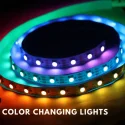2022-09-28
Light bulb Philippines suppliers – How to choose the right light bulb
A light-emitting diode, additionally recognized as an LED, is a semiconductor system that emits mild when its present-day flows thru it.
The first LED lights that were produced were red and low-intensity. During the 1980s, intensive R&D efforts led to the creation of super-bright and inexperienced LED lights. The leap forward was achieved when blue-colored LEDs were invented, which led to the development of more energy-efficient white LED lights.

Compared to their predecessors, LED lights are more energy-efficient. They use less power and have a lifespan of around 25 times longer. They are also more cost-effective.
The design of LED bulbs is similar to that of traditional bulbs, such as using a socket and a screw. They also imitate the light-emitting properties of the traditional lamp to meet the energy-saving habits of people. Due to the LED's unidirectional nature, designers have adjusted the lamp shape to ensure that its mild distribution curve is similar to that of an ordinary lamp.

Light bulbs are also known to have additional color temperature options. They can additionally be equipped with adjustable temperature settings, which can change the light's color. For instance, by using adjustable red, green, and blue ratios, LED lights can produce different light colors.
In our daily lives, we can encounter various kinds of Light bulbs. Understanding the various factors that affect the light's color temperature and appearance is very important to making informed decisions.
Watts
One of the most energy-efficient types of light bulbs is the light-emitting Diode, which features no mercury and is capable of producing brilliant light. It is also ideal for challenging lighting due to its ability to provide directional light. Some slight fixtures, such as those with built-in LED lights, are additionally known to have these features. These lights can last for up to 50,000 hours and are ideal for hard-to-reach areas.
Compact Fluorescent(CFL):

Led light bulb: These energy-efficient bulbs can provide a wide variety of colors depending on the model you choose. They usually take some time to heat up and produce brighter light. Use these lights in large spaces such as kitchens and basements.
Incandescent light bulb/ fluorescent lamps: Unlike LED lights, these bulbs are relatively inexpensive and can close much longer than their counterparts. However, they do contain mercury, which you should always deal with carefully.

Halogen: A type of light known as a halogen bulb is capable of producing a white light that simulates daylight. It is ideal for various types of lighting, such as pendant lights and floor lamps. Its lifespan is shorter than that of other bulbs.

Since halogen bulbs are very hot, they should be stored away from other potentially hazardous materials. You should also use gloves when handling them as oil from your arms can cause them to explode if they get too hot.
Lumens
The quantity of light that is produced by a light bulb is referred to as its lumen. The greater the light's intensity, the brighter it is. To determine how many light bulbs you need, you have to first locate the rectangular pictures of the room or the area you are trying to light.
If you are planning on pairing a light bulb with a moderate fixture, make sure that the base dimension matches the type of light it will be producing. Most moderate fixtures also have a label that says “mild bulb” on the socket.
On the website of home furnishings retailer Wayfair, you can also find this information in the product description of a mild fixture. We advise 20 light bulbs per square foot for most rooms. However, take a look at the desk below to see how many you need for every room in your house.
If you have a dark room or have wall panels that are covered in dark colors, you should also include an extra 10 light bulbs per square foot. This will allow you to light the entire room with a variety of light sources. One mild fixture will not be able to provide all the light that you need to mild the space.
Color Temperature

The various types of light bulbs that are available in your home are known as light bulbs. They can be produced in different colors, such as warm white, daylight, and candlelight. To determine which one is ideal for your home, you can use the color temperature chart below.
2600K-3000K: The warm white light bulbs are commonly used in various rooms, such as bedrooms and living rooms. They are also commonly used as wall and ceiling lights.
3000K-5000K: A cool white-colored alternative is known as neutral white, and it can be used for various types of light, such as kitchen and bathroom lights. You should always choose a 4000K light for this type of light.
5000K+: The warm white light bulbs are commonly used in various rooms, such as bedrooms and living rooms. They are also commonly used as wall and ceiling lights. A crisp mild that's equivalent to daylight can be used in areas that require light, such as reading or writing.
Light bulb Shapes
Light bulbs can be in various shapes, and they can complement your home's style. For instance, if you have a frequent chandelier, you might want to use light bulbs in this type of fixture.

Light bulb Bases
Before you buy a light bulb, make sure that the base of the product fits your moderate fixture. Most commonly, the base of the light bulbs is called an Edison, which has a screwed-in design.
Currently, LEDs are considered to be useless at around 70% of their initial light output. They do not produce the same amount of light as preferred lamps, and this is the reason why they are not commonly used. Diodes, on the other hand, can produce low output degrees for a long time.
The quality of the product is also a major factor that you should consider when it comes to choosing a company for your light bulbs. A company that has a large amount of research and development can ensure that its products are of high quality.

MLS Group is a leading organization that has a large number of companies that are involved in the production of light bulbs. One of these is Forest Lighting, which is one of the top 10 companies in the world that is known for its quality.
Over the years, the company has been able to develop several light bulbs through its R&D activities. It has four production bases, which are located in Guangdong/Yi Wu, Zhe Jiang/Jian, Fujian/XinYu, and 4 Center Laboratory.
Forest Lighting Focus on Core Competencies
Through its continuous innovation drive and process automation, Forest Lighting has been able to become one of the leading companies in the LED lighting industry. As a wholesale supplier, we can offer our customers high-quality products and exceptional service.

Streamlined and clear R&D efforts:
Due to the continuous support from its investors, Forest Lighting has been able to increase its R&D budget by over five hundred million Yuan. This has allowed the company to become a beacon for the Made in China 2025 initiative in the LED lighting industry. Its four production bases are located in Yiwu, Zhongshan, Ji’an, and Xinyu.

High quality and best price, perfect after-sales service
Forest Lighting is a leading supplier of light bulbs and Has a perfect quality assurance system. Besides LED lights, the company also offers other types of electrical equipment such as photo voltaic and industrial lighting.
We are very able in each manufacturing(OEM/ODM) and a wholesale light bulb or other lights (such as a led tube, led flood lights, and so on )needs, contact us today.






